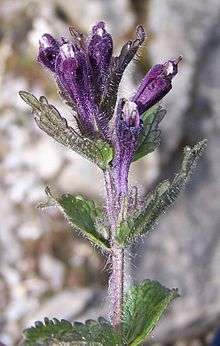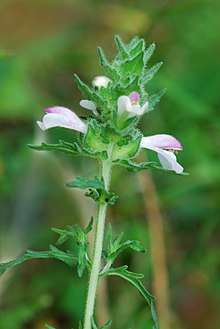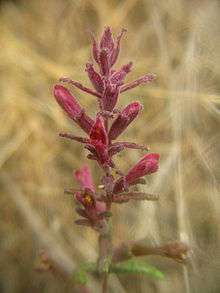Bartsia
| Bartsia | |
|---|---|
 | |
| Bartsia alpina | |
| Scientific classification | |
| Kingdom: | Plantae |
| (unranked): | Angiosperms |
| (unranked): | Eudicots |
| (unranked): | Asterids |
| Order: | Lamiales |
| Family: | Orobanchaceae |
| Tribe: | Rhinantheae |
| Genus: | Bartsia |


Bartsia is a genus of flowering plants in the broomrape family, Orobanchaceae.
Bartsia grows in damp places, such as marshes and wet meadows, in several parts of the west of England and Wales and in southwest Scotland.[1]
In Manitoba, Canada, the plant known as red bartsia (Odontites vernus, previously classified as Bartsia odontites) is considered a weed.[2]
Etymology
Bartsia was named after Johann Bartsch (Latinized as Johannes Bartsius, 1709-1738), a botanist of Königsberg. The plant was named for him by his associate Carl Linnaeus.
Phylogeny
The phylogeny of the genera of Rhinantheae has been explored using molecular characters.[3][4] Bartsia belongs to the core Rhinantheae. Bartsia sensu stricto (e.g. B. alpina) is the sister genus to Odontites, Bellardia, Tozzia, Hedbergia, and Euphrasia.
| Cladogram: Genus-level phylogeny of tribe Rhinantheae based on molecular characters (ITS, rps16 intron and trnK region).[3][4] | ||||||||||||||||||||||||||||||||||||||||||||||||||||||
|
|
Classification
In 1990, the genus was revised to contain 49 species; 45 of them are endemic to the Andes.[5] The most familiar species might be the well-studied Bartsia alpina, which has a circumboreal distribution, occurring throughout northern regions of the Northern Hemisphere.[6] There are also two African species. These two plants, B. alpina, and the many Andean species are three distinct lineages, making the genus polyphyletic.[7] Accepted species names include:[8]
Selected species
- Bartsia acuminata Pursh
- Bartsia adenophylla Molau
- Bartsia alba Molau
- Bartsia alpina L. – velvetbells
- Bartsia altissima Rusby
- Bartsia anomala Edwin
- Bartsia aprica Diels
- Bartsia asperrima (Link) Samp.
- Bartsia aurea Edwin
- Bartsia australis Molau
- Bartsia bartsioides (Hook.) Edwin
- Bartsia camporum Diels
- Bartsia canescens Wedd.
- Bartsia chilensis Benth.
- Bartsia crenata Molau
- Bartsia crenoloba Wedd.
- Bartsia crisafullii N.H.Holmgren
- Bartsia decurva Hochst. ex Benth.
- Bartsia diffusa Benth.
- Bartsia elachophylla Diels
- Bartsia elongata Wedd.
- Bartsia fiebrigii Diels
- Bartsia filiformis Wedd.
- Bartsia flava Molau
- Bartsia glandulifera Molau
- Bartsia inaequalis Benth.
- Bartsia integrifolia Wedd.
- Bartsia jujuyensis Cabrera & Botta
- Bartsia laniflora Benth.
- Bartsia laticrenata Benth.
- Bartsia longiflora Hochst. ex Benth.
- Bartsia melampyroides (Kunth) Benth.
- Bartsia mutica (Kunth) Benth.
- Bartsia orthocarpiflora Benth.
- Bartsia patens Benth.
- Bartsia pauciflora Molau
- Bartsia pedicularoides Benth.
- Bartsia peruviana Walp.
- Bartsia pumila Benth.
- Bartsia pyricarpa Molau
- Bartsia ramosa Molau
- Bartsia remota Molau
- Bartsia rigida Molau
- Bartsia santolinifolia (Kunth) Benth.
- Bartsia sericea Molau
- Bartsia serrata Molau
- Bartsia stricta (Kunth) Benth.
- Bartsia strigosa Molau
- Bartsia tenuis Molau
- Bartsia thiantha Diels
- Bartsia tomentosa Molau
- Bartsia trichophylla Wedd.
- Bartsia tricolor Molau
- Bartsia trixago L.
- Bartsia weberbaueri Diels
References
| Wikimedia Commons has media related to Bartsia. |
- ↑ Pratt, Anne (1899). The Flowering Plants, Grasses, Sedges,& Ferns of Great Britain and Their Allies, the Club Mosses, Horsetails, Etc. London: F. Warne. p. 26.
- ↑ Manitoba. "How To Control Red Bartsia". manitoba.ca. Retrieved December 6, 2015.
Red bartsia (Odontites serotina) is a weed of hayland, pastures and roadsides which appeared in the Interlake region of Manitoba in the 1950s... The weed apparently was introduced into the area in crates which were shipped from West Germany into the Canadian Armed Forces Base at Gimli. The infestation started on the base and spread into surrounding farmland by way of mowed hay from red bartsia infested areas along the edges of runways.
- 1 2 Těšitel, Jakub; Říha, Pavel; Svobodová, Šárka; Malinová, Tamara; Štech, Milan (2010-10-28). "Phylogeny, Life History Evolution and Biogeography of the Rhinanthoid Orobanchaceae". Folia Geobotanica. 45 (4): 347–367. doi:10.1007/s12224-010-9089-y. ISSN 1211-9520.
- 1 2 Scheunert, Agnes; Fleischmann, Andreas; Olano-Marín, Catalina; Bräuchler, Christian; Heubl, Günther (2012-12-14). "Phylogeny of tribe Rhinantheae (Orobanchaceae) with a focus on biogeography, cytology and re-examination of generic concepts". Taxon. 61 (6): 1269–1285.
- ↑ Molau, V. (1990). The genus Bartsia (Scrophulariaceae-Rhinanthoideae). Opera Botanica 102 5-99.
- ↑ Taylor, K. and F. J. Rumsey. (2003). Bartsia alpina L. Journal of Ecology 91(5), 908-21.
- ↑ Uribe-Convers, S. and D. Tank. Phylogenetic analysis of the genus Bartsia L. (Orobanchaceae): a mostly South American genus wrapped in a European Clade. Presentation abstract. Botany 2010. Providence, Rhode Island. August 4, 2010.
- ↑ Bartsia. The Plant List.